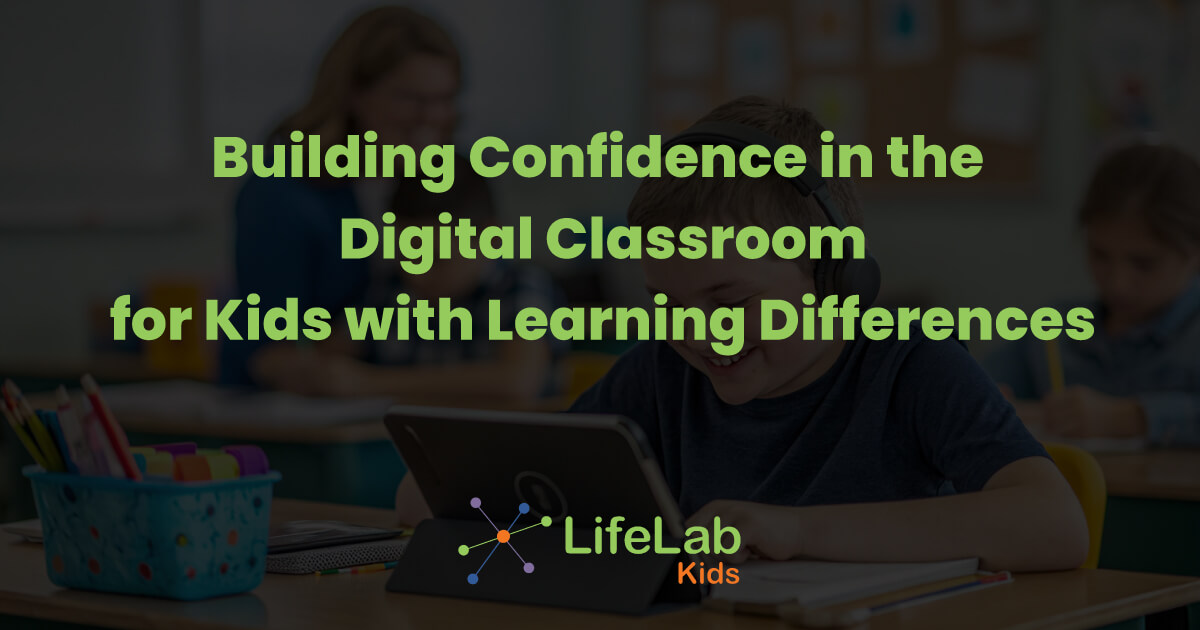Have you ever thought how safe and confident your child might feel when they are learning online? While the internet provides great opportunities, it may feel immense especially for children with learning differences. That’s the reason why building digital classroom skills for special needs students is more about helping the child to feel secure, supported, and proud of what they can do.
At LifeLab Kids, we have seen how a digital classroom can become more than just assignments and screens, and with the right guidance these spaces can turn into a space for growth, self-expression, and joy, where children celebrate strengths and build independence.
Understanding the Digital Classroom for Children with Learning Differences
A digital classroom provides an environment where children can connect, create, and learn using tools like chat, video, interactive activities, and visuals. For autistic children, these features can make learning easier and more comfortable:
It provides flexible ways to participate like typing, drawing, speaking, or using symbols.
- Visuals help in making lessons easier to follow.
- Self-paced activities which minimize pressure.
- Structured interactions which feel safe.
These tools may give the child a chance to feel more capable and confident, when it is paired with strategies.
Why Confidence Matters Online
A child starts to gain confidence when they start believing in oneself, being curious, and feel a part of their community. For children with learning differences, confidence in a digital classroom helps in:
- Taking part in activities without the worry of making mistakes.
- Building independence when they start exploring resources on their own.
- Developing resilience when they face any challenges.
- Telling about their needs and preferences.
When a child feels confident, they are more likely to discover new topics, trying creative projects or just sharing.
Start with Familiarity and Routine
Having a simple and consistent routine lets a child focus more on learning, they feel secure.
Different Ways to Support:
- Practicing logging in, finding lessons, and using class tools together.
- Creating a visual schedule which highlights start time, breaks, and activities.
- Previewing the day’s lesson to set their expectations.
These small steps minimize sensory overload, improve focus, and give children predictability.
Optimize the Learning Environment at Home
The home setup is as important as the classroom; a calm and organized environment supports focus and builds confidence.
Tips for parents:
- Using noise-cancelling headphones for children who are sensitive to noise.
- Adding visual cues for focusing on time.
- Keeping the supplies within the reach of the child.
- Adjusting the light and seats as per the comfort of the child.
This setup provides children with a sense of control and helps them feel ready to learn.
Build Digital Literacy Step by Step
Digital literacy also includes how to solve a problem, communicate, and safe exploration.
You can practice through simple activities:
- Typing messages or answers.
- With the help of educational games, learning to use mouse and touchpad control.
- Adjusting the audio and video settings.
- Learning online safety like choosing trusted websites and avoiding clicking on unknown links.
Each of these helps children in gaining independence and preparing for future learning.
Encourage Self-Expression in Multiple Formats
When a child has more than one way to express themselves, they glow. Digital tools provide these opportunities and open doors for creative pathways beyond words.
Things which you can try:
- Let children make a choice between typing or recording a short response.
- Using art, music, or photos in creative projects.
- Exploring assistive tech like speech-to-text or text-to-speech.
Foster Social Connections
Digital classrooms may provide a safe way to connect with friends and collaborate.
Ways to grow connections:
- Joining small breakout groups for teamwork.
- Encouraging online clubs or shared activities.
- Practicing respectful communication like taking turns, emojis and replies.
Collaborate with Teachers and Therapists
Parents play a key role in shaping digital learning. By providing details and staying connected with educators, children get the right balance of support.
Collaboration ideas:
- Sharing your child’ sensory and communication preferences.
- Working closely with teachers for adjusting assignments when required.
- Reviewing upcoming lessons so that the child is well prepared.
Bring Life Skills into Digital Learning
Online learning may also become a space for practicing everyday skills:
- Time management: Using timers for tasks.
- Organization: Sorting and labeling digital files.
- Responsibility: Remembering logins and submitting assignments.
A child carries these skills beyond the classroom into real-world independence.
Turning Challenges into Opportunities
Every child learns differently and at their own pace. With planning, patience, and encouragement, digital classrooms may be less like a challenge and more like an opportunity.
At LifeLab Kids, we believe that every child holds abilities waiting to be celebrated. By focusing on digital classroom skills for special needs students, parents and educators together can create experiences that spark confidence, curiosity, and lasting growth.
Conclusion
This shift to digital learning has shown that education can be inclusive, flexible, and creative. For children with learning differences, the right environment helps online learning become a place for connecting, expressing and building confidence.
When parents, teachers, and therapists come together, digital tools become more than just screens, they become bridges to skills, friendships, and self-belief.

